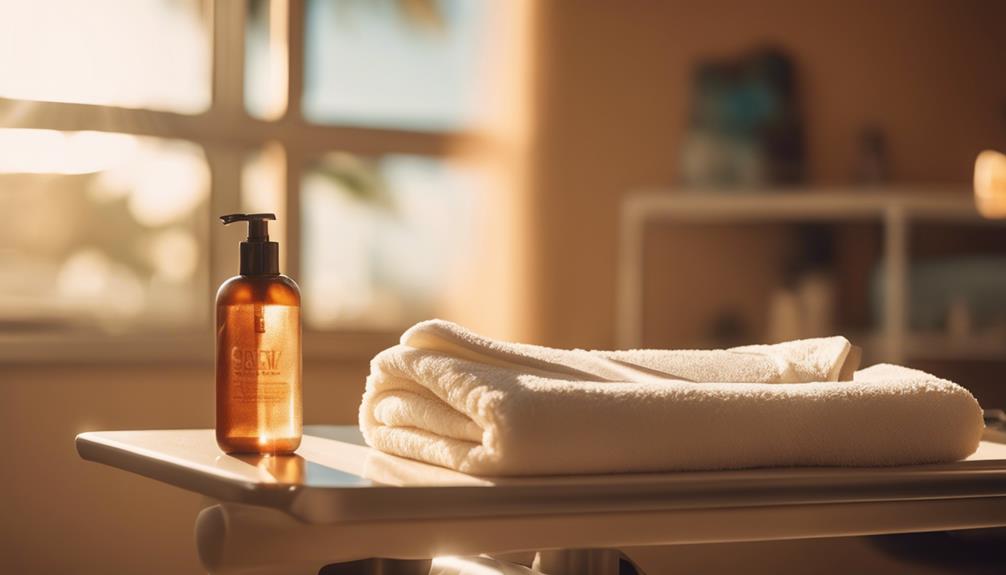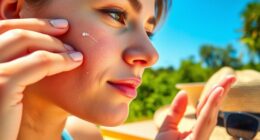Tanning is an art you can master with the right preparation. First, know your skin type to determine the best approach. Hydrate your skin and exfoliate before tanning for even results. Always wear protective eyewear and start with short sessions of 5 to 8 minutes to gauge how your skin reacts. After tanning, delay washing your skin and keep it moisturized to maintain your glow. Remember, consistency is key to achieving that perfect tan. As you explore further, you'll uncover more tips and techniques to enhance your tanning experience effectively.
Key Takeaways
- Understand your skin type to determine suitability for tanning and avoid excessive burns or skin issues.
- Prepare your skin by exfoliating and hydrating beforehand for better tanning results.
- Use protective eyewear and consult experts for appropriate tanning session durations.
- Choose the right tanning equipment, like stand-up beds for hygiene and control.
Understanding Skin Types
Understanding your skin type is essential for safe and effective tanning, as it determines how your skin reacts to UV exposure. Recognizing your skin type allows you to tailor your indoor tanning sessions appropriately.
If you have Skin Type 1, you've got pale skin that burns easily and doesn't tan at all. Indoor tanning isn't suitable for you.
Skin Type 2 features fair skin that also struggles to tan, so you'll need to take extra precautions during your sessions to avoid burns.
With Skin Type 3, you possess light brown or olive skin that tans gradually. You can generally tolerate moderate tanning sessions, but keep an eye on your skin's response.
If you fall into Skin Type 4, your caramel or medium brown skin tans easily and rarely burns, giving you a higher capacity for tanning.
Finally, Skin Type 5 includes those with bronze or rich brown skin, who can tan effortlessly without burning. While you'll have minimal risk during indoor tanning, it's still important to approach your sessions responsibly.
Knowing your skin type helps guarantee a safer, more enjoyable tanning experience.
Preparing Your Skin

Before you start tanning, it's vital to assess your skin type and prep your skin properly.
Exfoliating and hydrating your skin will help you achieve a smoother, more even tan, while removing makeup guarantees there are no barriers to absorption.
Let's go over the essential steps to get your skin ready for that perfect glow.
Skin Type Assessment
Assess your skin type on a scale from very pale to rich brown to determine how well you can tan and the precautions you should take. Your skin type assessment is essential, as lighter skin types (Type 1) typically burn easily and need to be more cautious with sun exposure.
If you have darker skin (Type 4 or 5), you may tan more easily, but it's still important to monitor your skin's reaction to UV rays.
Before tanning, consider any medications you take that might increase UV sensitivity. Some prescriptions can heighten your risk of burning or cause adverse reactions, so it's critical to check this beforehand.
In preparation for tanning, you should also focus on moisturizing. Apply a light, non-oil based moisturizer to enhance hydration, which can help achieve a deeper, longer-lasting tan. This step not only prepares your skin but also promotes an even tan.
Exfoliation and Hydration
Preparing your skin for tanning involves both exfoliation and hydration to guarantee an even and lasting glow.
Start by exfoliating your skin 1-2 days before your tanning session. This helps remove dead skin cells, ensuring your skin is smooth and ready to absorb tanning products effectively. Use a gentle body scrub to avoid irritation, keeping your skin comfortable and receptive.
After exfoliating, it's crucial to moisturize your skin to maintain hydration. Opt for a non-oil-based moisturizer, applying it right after you shower. This keeps your skin hydrated, preventing any dryness that can lead to uneven tanning results. Make sure to choose a reputable brand, like Premier Collection, for the best results.
Don't forget about internal hydration! Drink plenty of water leading up to your tanning session. Staying hydrated helps keep your skin plump and healthy, enhancing the overall tanning process.
Makeup Removal Tips
Removing makeup is essential for achieving an even tan, as leftover products can lead to uneven results and unwanted patches. To prepare your skin effectively, follow these makeup removal tips.
| Step | Description |
|---|---|
| 1. Choose Wisely | Use gentle cleansers or makeup removal wipes. |
| 2. Skip Oils | Avoid oil-based removers to prevent residue. |
| 3. Focus Areas | Pay special attention to the eyes and lips. |
| 4. Be Thorough | Confirm all areas are completely clean for ideal results. |
| 5. Exfoliate | Perform a light scrub 1-2 days before tanning. |
Safe Tanning Practices

To guarantee a safe tanning experience, always wear protective eyewear designed for tanning, as this can prevent serious eye damage from UV exposure.
It's important to consult a tanning expert to determine your skin type and follow their recommended exposure times to minimize your risk of burns and long-term skin damage.
Start with short tanning sessions of just 5 to 8 minutes. Allow at least 48 hours between sessions to give your skin time to recover and avoid overexposure. This approach is vital for practicing safe tanning practices.
When you do tan, use indoor tanning lotions specifically formulated for sunbed use. Regular lotions can irritate your skin and damage the tanning beds, so stick to products made for this purpose.
After tanning, maintain a consistent skincare routine. Regularly moisturizing your skin won't only keep it healthy but also help prolong your tan.
Choosing the Right Equipment

When you're choosing tanning equipment, think about the different types of beds available, like lie-down or stand-up options.
Each type offers a unique experience and can impact your tan's final look.
Don't forget to check for safety features and ask salon staff for advice tailored to your skin type and goals.
Tanning Bed Types
Choosing the right tanning bed type is essential for achieving the best results while ensuring your safety and comfort. Tanning beds come in two main types: lie-down beds and stand-up beds.
Lie-down beds offer a larger surface area, allowing you to relax while tanning, but stand-up beds promote hygiene by minimizing surface contact and providing a more even tan with 360-degree exposure.
For first-time users, starting with a stand-up tanning bed is often recommended. It helps deliver a uniform tan while allowing you to control your exposure time better. As you gain experience, you can gradually increase the duration based on your skin's response to avoid burning.
When considering tanning beds, keep in mind that they vary in levels (e.g., Level 1, Level 2, Level 3), which differ in intensity and UV output. Higher levels offer deeper, longer-lasting tans but also come with increased UV exposure.
Always consult the tanning salon staff to determine the most suitable bed type and session duration based on your individual skin type and tanning experience. This guidance will help you achieve your desired results safely and effectively.
Safety Features Importance
Selecting the right tanning equipment is essential for ensuring your safety and enhancing your tanning experience. When you visit a salon, opt for well-maintained, FDA-approved tanning beds. These beds not only provide effective results but also incorporate safety features that minimize risks associated with UV exposure.
Always prioritize your eye safety by using disposable protective eyewear or personal tanning goggles. This simple step can help prevent serious eye damage during your sessions. It's also wise to choose tanning equipment equipped with built-in timers and stop buttons, allowing you to control your tanning duration and reduce the chances of overexposure.
Consider standing tanning beds as well; they often offer better hygiene since you won't come into contact with the bed surface. Before you start tanning, consult with the salon staff for personalized recommendations tailored to your skin type and tanning goals.
They can guide you in selecting the best equipment that combines safety features with effective results. By taking these precautions, you'll not only achieve a beautiful tan but also protect your health in the long run.
Tanning Products Overview

Tanning products offer a range of options, from instant bronzers to melanin-boosting intensifiers, ensuring you find the perfect match for your tanning goals. Here's a quick overview of the main types of tanning products available:
| Product Type | Description |
|---|---|
| Bronzers | Contain pigments for immediate color, giving you a quick tan. |
| Intensifiers | Stimulate melanin production for a deeper, more natural tan. |
| Tanning Lotions | Specifically designed for indoor tanning; include moisturizing ingredients to enhance hydration. |
When choosing your products, consider your skin type. If you have sensitive skin, look for hypoallergenic options to minimize irritation. Remember, using tanning lotions designed for indoor use is essential, as conventional oils can interfere with UV exposure. Regular application of these products, combined with proper skin preparation and aftercare, can greatly extend the longevity and quality of your tan. So, whether you prefer a quick bronzer or a gradual intensifier, you'll find a product to help you achieve the sun-kissed look you desire.
Application Techniques

Mastering application techniques is vital for achieving a flawless, sun-kissed glow without streaks or patchiness. Start by exfoliating your skin before applying any tanning lotion. This step enhances absorption and helps you achieve a more uniform tan.
When you're ready to apply, use a small amount of product—about a pea-sized amount—for your face. This guarantees even coverage and minimizes the risk of streaking.
For your body, distribute the tanning lotion evenly, paying special attention to areas that often get missed, like elbows and knees. Don't rush; take your time to cover every inch.
After application, let the tanning lotion dry completely before dressing. This is significant for maximizing the product's effectiveness. If you don't allow it to dry, you risk smudging your tan.
Aftercare for Your Tan

After tanning, you'll want to be mindful of how you care for your skin to keep that glow intact.
Start by waiting a few hours before showering and skip any harsh soaps that could fade your color.
Incorporating a good moisturizer will help prolong your tan and keep your skin looking its best.
Post-Tanning Shower Guidelines
Following your tanning session, it's important to wait a few hours before showering to guarantee your tan fully develops. This allows the color to set properly, ensuring you get the best results from your tanning efforts.
When you're finally ready for your post-tanning shower, keep these guidelines in mind:
- Use Cool Water: Opt for cool water instead of hot, as hot water can strip away your tan and leave your skin feeling dry.
- Gentle Cleansing: Choose a mild soap to cleanse your skin. Avoid harsh scrubs that can irritate and damage your tan.
- Drying Technique: Instead of rubbing, pat your skin gently with a soft towel. This helps prevent irritation and maintains your tan's integrity.
- Hydrate Your Skin: After your shower, consider applying a moisturizing body lotion. This step is essential for promoting skin hydration and keeping your tan looking fresh.
Moisturizing for Longevity
Moisturizing regularly is essential for keeping your tan looking vibrant and preventing dryness that can lead to uneven fading. After your tanning sessions, apply a high-quality indoor tanning lotion that's specifically formulated for after-tan care. These lotions provide vital nutrients and moisture, considerably enhancing your tan longevity.
Make it a habit to moisturize daily. This consistent routine won't only keep your skin hydrated but also improve its overall texture and appearance, making your tan look more radiant. Dry, flaky skin can quickly diminish the results of your tanning efforts, leading to patchy or uneven color.
When selecting products, opt for gentle, moisturizing body washes instead of harsh soaps or cleansers, as these can strip the color and undermine your tan. After showering, while your skin is still damp, apply your moisturizer to lock in hydration effectively.
Avoiding Harsh Products
To preserve your tan and keep your skin healthy, steer clear of harsh soaps and scrubs that can strip away color and moisture. Instead, focus on gentle products to maintain your glow. Here are some tips to help you with aftercare:
- Choose Gentle Cleansers: Opt for moisturizing, sulfate-free cleansers that keep your skin hydrated and prolong your tanning results.
- Use After-Tan Lotions: Look for after-tan lotions designed specifically for indoor tanning. These often have nourishing ingredients to help maintain your tan.
- Moisturize Regularly: After tanning, apply moisturizers daily to combat dryness from UV exposure, enhancing the appearance of your tan while promoting overall skin health.
- Avoid Hot Showers: Wait at least 24 hours before showering and steer clear of hot water, as it can accelerate fading.
Frequency of Tanning Sessions

Beginners should start with tanning sessions lasting 5 to 8 minutes to assess how their skin reacts and prevent burning. It's crucial to monitor your skin for any signs of overexposure, such as redness or discomfort. After your initial session, wait at least 48 hours before your next tanning session to give your skin time to recover from UV exposure.
Gradually increase your session duration as your skin adapts, but always be cautious. For ideal results, aim to tan 1-3 times per week once you've achieved a base tan. This frequency helps maintain your color while minimizing the risk of skin damage.
Here's a simple guide to help you plan your tanning sessions:
| Tanning Stage | Recommended Duration |
|---|---|
| Initial sessions | 5-8 minutes |
| After 1st session | 8-10 minutes |
| After 2nd session | 10-12 minutes |
| Maintenance sessions | 1-3 times a week |
| Skin reaction check | Monitor after each session |
Tracking your progress will help you adjust the frequency and duration based on your individual skin type and response.
Benefits of Indoor Tanning

Indoor tanning offers several benefits, making it a popular choice for those seeking a controlled and convenient way to achieve a desired tan. Here are some key advantages you'll enjoy:
- Convenience: You can tan whenever you want, without worrying about unpredictable weather or extended sun exposure.
- Skin Conditions: Indoor tanning can help alleviate symptoms of skin issues like eczema and psoriasis by providing beneficial UV light.
- Mood Booster: If you struggle with seasonal affective disorder (SAD), indoor tanning can elevate your mood and promote relaxation, thanks to the UV exposure.
- Vitamin D Supply: Tanning beds provide a source of vitamin D, which is essential for bone health and may lower the risk of certain cancers.
In addition to these benefits, indoor tanning enhances your skin's texture and provides that bronzed look many desire.
Just remember to use indoor tanning responsibly to maximize the benefits while minimizing risks. Enjoy your tanning experience, and embrace the glow!
Common Tanning Myths

Many people believe in common tanning myths that can lead to dangerous misconceptions about safety and skin health. One prevalent myth is that tanning beds are completely safe, but studies show they increase your risk of skin cancer by 75% and melanoma by 20%. You might think that getting a base tan in a tanning bed can protect you from sunburn, but this can actually result in overexposure and serious skin damage.
Another misconception is that using sunscreen allows you to avoid the risks associated with tanning beds. However, traditional sunscreens don't provide adequate protection against the UV radiation these beds emit. Many also assume that indoor tanning helps maintain a year-round tan, but the truth is that tanning fades over time and requires constant upkeep.
Lastly, it's crucial to recognize that not all skin types can safely use tanning beds. If you have very fair skin (Skin Type 1), you should steer clear of tanning beds due to the high risk of burning and skin damage. Always prioritize your skin health by debunking these myths and using protective eyewear when tanning.
Frequently Asked Questions
What to Know Before Tanning for the First Time?
Before tanning for the first time, know your skin type, exfoliate and moisturize 1-2 days ahead, remove makeup and jewelry, consult salon staff for advice, and always wear protective eyewear during sessions.
How Long Should a Beginner Sit in a Tanning Bed?
As a beginner, you should start with 5 to 8 minutes in the tanning bed. After each session, wait 48 hours before increasing time gradually, ensuring your skin adapts without burning. Always prioritize skin safety.
What Do I Need to Know Before Self Tanning?
Before self-tanning, know your skin type and exfoliate 1-2 days prior. Always moisturize, but skip oil-based products. Do a patch test to check for reactions, and wait four hours before showering for best results.
What Is the Golden Rule of Tanning?
The golden rule of tanning is like a lifeline for your skin. You've gotta prioritize your skin's health, limit UV exposure, and always choose the right products. Balance is key to achieving that sun-kissed glow safely.
What Are the Best Practices for Tanning to Ensure Long-lasting Results?
To ensure long-lasting results for your tan, there are a few expert tips for maintaining tan that you can follow. First, exfoliate your skin before tanning to remove dead skin cells. Second, moisturize regularly to keep your skin hydrated. Finally, avoid extended sun exposure and use sunscreen to protect your tan.
Conclusion
As you plunge into the world of tanning, remember that a golden glow should enhance your beauty, not overshadow it.
By understanding your skin type and following safe practices, you're not just chasing a summer sun but crafting a radiant masterpiece of your own.
Embrace the journey, care for your skin, and let your confidence shine brighter than any tan.
After all, it's not just about the color you wear, but how it makes you feel inside.








